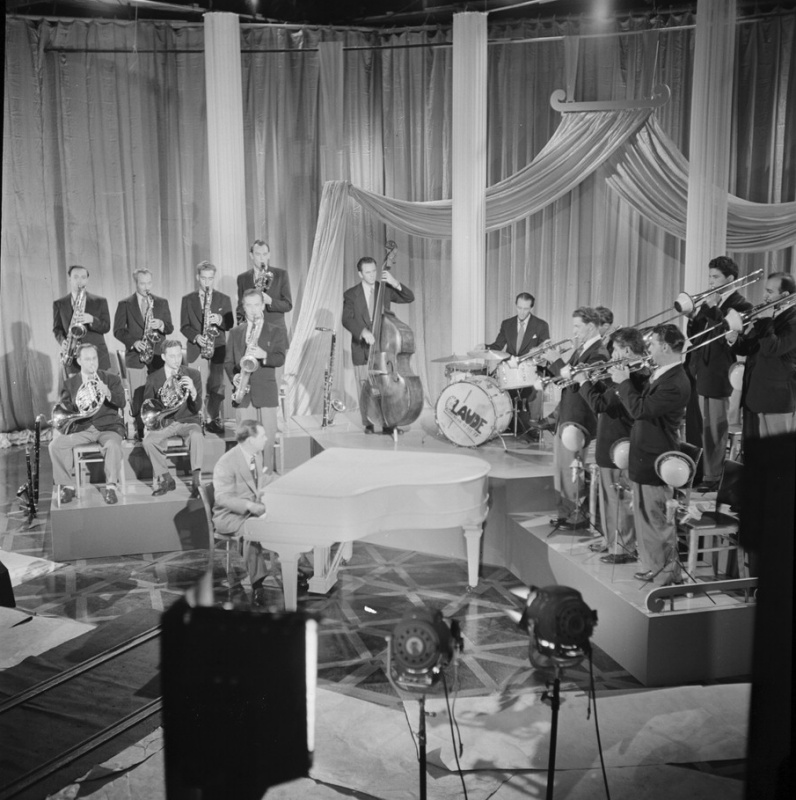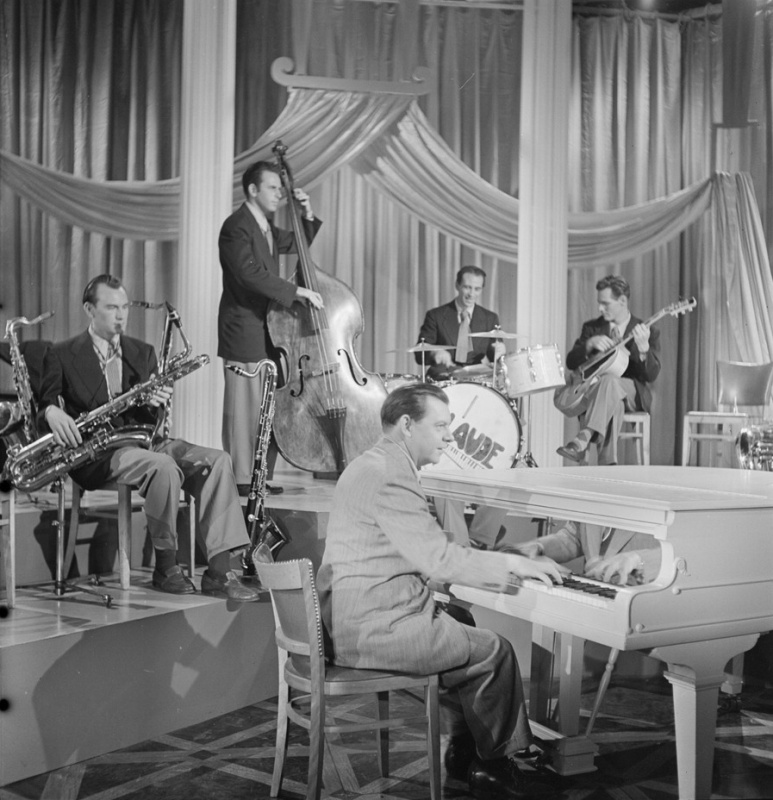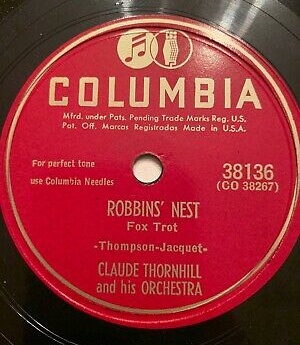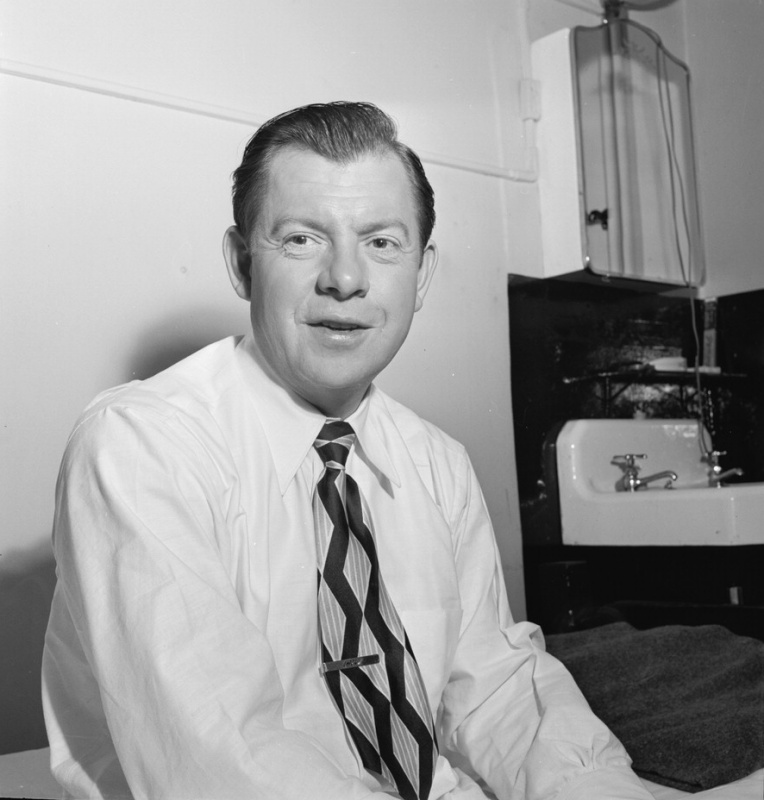Claude Thornhill Plays Robbins’ Nest – Cool Jazz In Gestation

Here’s a name I’ll bet you’ve never heard: Claude Thornhill. He led one of the most influential bands you have never heard of. Click on, I promise I’ll make it worth your while.
We from Indiana sometimes joke about the city of Terre Haute, something along the lines of how nothing good ever came from there. Actually there are a few things: Clabber Girl Baking Powder (and its owner Tony Hulman who bought the Indianapolis Motor Speedway after the war), St. Mother Theodore Guerin (our only local Catholic Saint whose order of nuns still resides there) and the Rose-Hulman institute of Technology – a highly regarded (and highly expensive) private school of engineering.
To this short list you can add one other name – Claude Thornhill. Born there in 1909 (his mother was a church organist), he displayed much musical talent by the time he left Garfield High School at age 16 and enrolled at the Cincinnati Conservatory of Music.
After some local performing he headed to New York along with Artie Shaw, where he made his bones playing piano with different bands and then arranging for them. He went to the west coast to arrange for Bob Hope’s radio band and worked with some movie studios as well. He was much better known among musicians than he was among the public when he decided to form his own band in 1940.

Thornhill’s original band was one of a kind, one that featured unusual combinations of instruments and that was all about finding the kinds of effects and tone colors that eluded the normal bands of the day. Although not our featured record, his 1941 recording of Snowfall (his own composition and arrangement) is one of the most beautiful things from its time period.
There were bands that were highly popular with dancers and listeners and bands that were highly popular with musicians, and Thornhill’s was of the latter kind. That almost all of his players re-joined him after the war tells you that they found his music worthwhile.
The 1947 band featured here is considered to be his third try. He was not a natural as a band leader, and certainly did not excel as a “personality”. Bebop was the hot new trend of the time and this band took on some of that flavor, but as only Claude Thornhill could do it.

Dynamics. That is the word that musical people use to describe how loudly or softly something is played. Every jazz player has used dynamics as part of his (or her) toolbelt in order to create tension and interest in a piece. Thornhill used this tool better than pretty much any other band, going from extremely soft passages to brief loud bursts. I read somewhere that he once said that his band was never recorded properly. The engineers would boost the sound level for passages they felt were too quiet, only to turn the levels down when the band hit full throttle. Of course, recording tech of the 1940’s did not make that situation better.
Perhaps I misspoke at the outset when I expected that you have never heard of Thornhill. If you have been paying close attention you might recall the name mentioned when we wrote about Miles Davis and his Nonet, famous for the handful of 1949 recordings that made up the reissue album entitled Birth Of The Cool.
The core of that group came out of Thornhill’s band, most notably arranger Gil Evans who wrote most of the band’s stuff. Just as in the later Davis group, this band played with almost no vibrato, favoring plain, straight tones and unusual combinations of instruments (flugelhorns and bass clarinets?), often in unison. This group really broke most of the rules about how a commercially successful big band was supposed to sound. OK, maybe not all that successful, but successful enough to get on a major record label.
Robbin’s Nest was one of those songs that briefly exploded on the scene with several recorded versions . Written by Illinois Jacquet and Sir Charles Thompson, it was first recorded by Illinois Jacquet and his All Stars in May of 1947. The title paid tribute to an early New York disc jockey, Fred Robbins, who’s Robbin’s Nest radio program was an early promoter of bebop recordings.
The song has had a certain amount of durability as a jazz standard, although as one well down in the bottom half of the list in terms of exposure. That Claude Thornhill’s outfit would record it would have been expected. Not surprisingly, it would become the most iconic early version of the piece due to Gil Evans’ unique arrangement.

Recorded October 16-17 of 1947, it was released by Columbia Records as the “B” side of a now-obscure vocal number in March of 1948. The record displays a “west coast” sensibility, a kind of “cool jazz” before cool jazz was a thing. Then there are some hat tips to bebop, particularly in the abrupt and somewhat disjointed short phrases that are used in the way a little hot sauce can spice up a dish of comfort food.
Claude Thornhill may have been the most delicate and nuanced piano player of the big band era. There was a gentleness to his sound that provided a relaxed, almost cloud-like aura, setting the stage for a band that would run from a sound nearly as delicate as that of its leader to the occasional full-throat blast, just for a little variety.
There is so much to like in this record, it is difficult to know where to start. I will go with two highlights: First, at about the 2:30 mark comes one of the most unusual things ever done with a big band – Gil Evans wrote what was, in essence, a bebop-ish solo line which was played in unison by the entire band. You can listen to a thousand jazz records and never hear anything else quite like this.
Also, there is the end. It is not abrupt, but after a brief flourish by the band the entire group descends into a delicate hush that sums up what was so special about this band.
Thornhill had his share of trouble, he suffered from some form of mental illness that resulted in occasional electro-shock treatments. And, of course, not even the most popular leaders could navigate the changing tastes and economics of the music business that banished the big bands to the fringes of jazz after about 1948.
He did, however, continue to play in groups of his own, both big and small, until he succumbed following two heart attacks in quick succession in 1965 at the age of 56. I suppose that in the world of musicians of his era, this was not so much tragic as normal.

Claude Thornhill is probably leaning against the fence that marks the outer boundary of musical obscurity for most younger fans. And by younger I mean people my own age, of course – people who came along after he had been at least modestly well known.
It has been reported that upon Thornhill’s death, no less than Duke Ellington called his widow and said to her “I wonder if the world will ever know how much it had in this beautiful man.” Perhaps now a few more of us might.
Photo Credits
Lead photo – Public domain photo from William Gottlieb, Sept 1947 at Columbia Pictures New York studio.
Full band photo – Public domain photo from William Gottlieb, Sept 1947 at Columbia Pictures New York studio.
Third photo – Public domain photo from William Gottlieb, Sept 1947 at Columbia Pictures New York studio. Portrait of Micky Folus, Joe Shulman, Claude Thornhill, Billy Exiner, and Barry Galbraith, Columbia Pictures studio, the making of Beautiful Doll, New York, N.Y., ca. Sept. 1947
Final photo – Public domain photo from William Gottlieb, March 1947 backstage at the Strand Theater, New York.
Music Source: From the YouTube channel of OverJazz Records
Band Personnel: Eddie Zandy, Paul Cohen, Louis Mucci (trumpets); Tak Tavorkian, Allan Langstaff (trombones); Walt Welscher, Sandy Siegelstein (flugelhorns [or french horns, depending on the source]); Bill Barber (tuba); Danny Polo, Lee Konitz (clarinet, alto sax); Mario Rollo (clarinet, tenor sax); Bill Buschey (clarinet, bass clarinet, baritone sax); Mickey Folus (bass clarinet, baritone sax); Barry Galbraith (guitar); Claude Thornhill (piano); Joe Shulman (bass); Bill Exiner (drums); Gil Evans (arranger). From Gil Evans: Out of the Cool – His Life and Music by Stephanie Stein Crease (2003)

I can see parts of that being all sorts of “fun” for a recording engineer in those days. The brass/clarinet transition at 2:07 & the brass/piano at 3:07 stand out.
Now I’m wondering how much the development of multi-track recording influenced the creation of music with that sort of volume range?
LikeLike
Agreed – there was only so much the equipment of the day could capture. And those engineers had to look out for record buyers who played the discs on all kinds of lousy equipment. This is one of those bands that would have really benefited from the tech of even a decade later.
LikeLike
Oh, that’s just lovely. A giant bowl of mashed potatoes with an occasional diced Jalapeno bit in there to surprise you. Good things *do* come from Terre Haute!
LikeLiked by 1 person
When I do one of these I listen to the music a number of times that would have most people screaming and running away, vowing to never play the song again. I am surely beyond 50 plays of this one in the past week and I still have not tired of it. There are just so many layers to this and so many different things going on, but all woven together so smoothly that you don’t really notice it all at first.
Information is sparse but it is possible that the clarinet solo was by a guy named Danny Polo, a friend from Thornhill’s youth who came from nearby Clinton, Indiana. But with all of those clarinets in this band it is hard to say.
LikeLike
I’ve been to Clinton! Nice little town.
I have added every song you’ve ever showcased on your blog to a Pandora station. (Those that Pandora has, anyway; it’s missing one or two.) I’ll keep adding songs as you showcase ’em. Here it is: JPC Radio!
https://www.pandora.com/station/play/4369127109029951314?part=ug-desktop&corr=4355922
LikeLike
Haha, wow – I will have to spend some time on “my” station. Should I be scheduling some public appearances or something? 🙂
LikeLike
Take a bow, my friend!
LikeLiked by 1 person
Hmm, I think I’m getting jazzed out, but I never knew the relationship between Tony Hulman of Indy fame, and Clabber Girl baking powder. And now I do. But what the heck is a Clabber Girl anyway? Now there’s a topic for a future JPC blog.
LikeLike
Jazzed out? Such a thing is possible? 😀
You made me look up Clabber Girl. Clabber was/is apparently a kind of soured milk and was an ingredient in a concoction that resulted in baking powder in the nineteenth century. The Hulman product began life is Milk Brand, then changed to Clabber in 1899. It became Clabber Girl in 1923 in reference to the package artwork that was on the 1899+ cans.
The family finally sold the consumer products earlier this year and the Speedway in a surprise announcement earlier this past week.
LikeLike
This is really wonderful—both the music and your discography. I think I could listen to this rich, gentle, lilting recording repeatedly.
Though I would have failed the test if quizzed about where I first heard Claude Thornhill’s name, it certainly did sound familiar. And I understand Duke Ellington’s words of praise to his widow.
LikeLike
You have provided my biggest reward in one of these musical odysseys. I love it when I can bring something new to folks, and I feel like I hit the jackpot when someone likes it. So thank you!.
When I was a teenager the secondhand stores had piles of cast-off 78 rpm discs priced at maybe a quarter apiece. I remember seeing Thornhill records but never buying one. I didn’t actually pay attention until years later when I heard one on one of the little radio stations that used to play this kind of stuff. They would have been so much better than a lot of the stuff I actually bought. 😀
LikeLike
I sent Frank L Parker from across the pond to you. He’s writing a continuous memoir, and most recently, he mentioned jazz greats. I told him about your in-depth coverage, and he said he’ll check it/you out.
LikeLike
Well, it’s interesting alright. There’s a lot going on, but to me it’s too much, like a bunch of clips from other songs patched together with jarring transitions.
But, once again that’s a band and I song I’d never heard of, thanks for the listen
LikeLike
I enjoy seeing the varied reactions from those who have never heard something. Perhaps you have hit on one of the reasons that the vocalists were taking over for the bands during this era.
LikeLike
Pingback: Gerry Mulligan And Chet Baker – Two Cool Cats | J. P.'s Blog
Excellent summation of Thornhill and his orchestra.
One correction I might make, though: Welscher and Siegelstein played French Horns, not flugelhorns.
LikeLiked by 1 person
Thank you, Wade, for your comment and for this additional information. I always appreciate information from those who have deeper background in something than I do – I don’t always get to dig as deeply as I would like in some of these subjects.
LikeLike